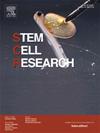Generation and characterization of the CSSi021-A (15665) human induced pluripotent stem cell line from a Smith-Magenis syndrome patient with a heterozygous RAI1 mutation
IF 0.8
4区 医学
Q4 BIOTECHNOLOGY & APPLIED MICROBIOLOGY
引用次数: 0
Abstract
Smith-Magenis syndrome (SMS) is a rare neurodevelopmental disorder caused by haploinsufficiency of the Retinoic Acid Induced 1 (RAI1) gene located at 17p11.2. It is estimated that approximately 90% of patients have a 17p11.2 deletion, including the RAI1 gene, while the remaining 10% exhibit a heterozygous mutation in the RAI1 gene. In this study, we report the generation of a human induced pluripotent stem cell (hiPSC) line derived from a 14-year-old female with an RAI1 mutation, which led to the onset of the SMS phenotype, starting from primary fibroblasts.
具有RAI1杂合突变的Smith-Magenis综合征患者CSSi021-A(15665)人诱导多能干细胞系的产生和特性
Smith-Magenis综合征(SMS)是一种罕见的神经发育障碍,由位于17p11.2的维甲酸诱导1 (RAI1)基因单倍性不足引起。据估计,大约90%的患者有17p11.2缺失,包括RAI1基因,而其余10%的患者表现为RAI1基因的杂合突变。在这项研究中,我们报道了从一名14岁的女性身上获得的人类诱导多能干细胞(hiPSC)系,该女性携带RAI1突变,导致SMS表型的发生,从原代成纤维细胞开始。
本文章由计算机程序翻译,如有差异,请以英文原文为准。
求助全文
约1分钟内获得全文
求助全文
来源期刊

Stem cell research
生物-生物工程与应用微生物
CiteScore
2.20
自引率
8.30%
发文量
338
审稿时长
55 days
期刊介绍:
Stem Cell Research is dedicated to publishing high-quality manuscripts focusing on the biology and applications of stem cell research. Submissions to Stem Cell Research, may cover all aspects of stem cells, including embryonic stem cells, tissue-specific stem cells, cancer stem cells, developmental studies, stem cell genomes, and translational research. Stem Cell Research publishes 6 issues a year.
 求助内容:
求助内容: 应助结果提醒方式:
应助结果提醒方式:


